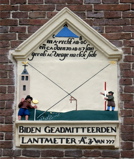
 The picture opposite shows a tablet that the surveyor Sytske Gravius had
put in the façade of his house at Raadhuisstraat 10, Grouw
(Friesland, Netherlands)
in 1655. The tablet was made by a fellow-surveyor, Syoerdt Aetesz
Haeckema, who was also a sculptor. At the time they were both working in
the province of Friesland on an ordnance survey project for an atlas, which
eventually was published in 1664.
The picture opposite shows a tablet that the surveyor Sytske Gravius had
put in the façade of his house at Raadhuisstraat 10, Grouw
(Friesland, Netherlands)
in 1655. The tablet was made by a fellow-surveyor, Syoerdt Aetesz
Haeckema, who was also a sculptor. At the time they were both working in
the province of Friesland on an ordnance survey project for an atlas, which
eventually was published in 1664.
The tablet consists of three parts:
In 1926 the stone tablet was moved to the Rijks H.B.S. (a secondary school) in Drachten (Friesland) on the initiative of H.K. Schippers, who was at that time teaching Maths at this school.In A recht. AB, BC en CA doen 30. AB is 7 langer als AC. Vrage na elck side.That means: "Angle at A right. AB, BC and CA total 30. AB is 7 longer than AC. How long is each side?"
Biden geadmitteerden Lantmeter. Ao z van 777.That means: "By the Official Surveyor - A. D. z of 777."
The origin and meaning of the 'z', together with an explanation of this date
riddle can be
found in a typed manuscript (dated 1941) by the above mentioned teacher.
The arabic word mal means wealth,
but can also signify the square of a number.
In medieval Latin, accordingly, the word
census (literally measuring of property, tax)
was used for square. In Italian this was written
censo or zenso,
abbreviated 'z'.
The manuscript mentions as sources of this information the following books:
David Eugene Smith, History of Mathematics, Ginn and Company, 1925,
Vol. 2, p.394
and
Heinrich Wieleitner, Rechnen und Algebra, Berlin, Otto Salle, 1927.


The picture of the tablet put back at the wall in Grouw which is used here, was made by Mieke den Boer-Snoei.
I wish to thank the late Fred Ferro for much information.
See also his article on this subject in the Dutch journal Monumenten 18 (1997), nr. 9, p.15, reprinted in De Hollandse Cirkel 4 (2002), nr.3. p.7.
The nice collection of photos of gable stones made by the late Fred Ferro
can be seen on the
image bank of Dutch cultural heritage.